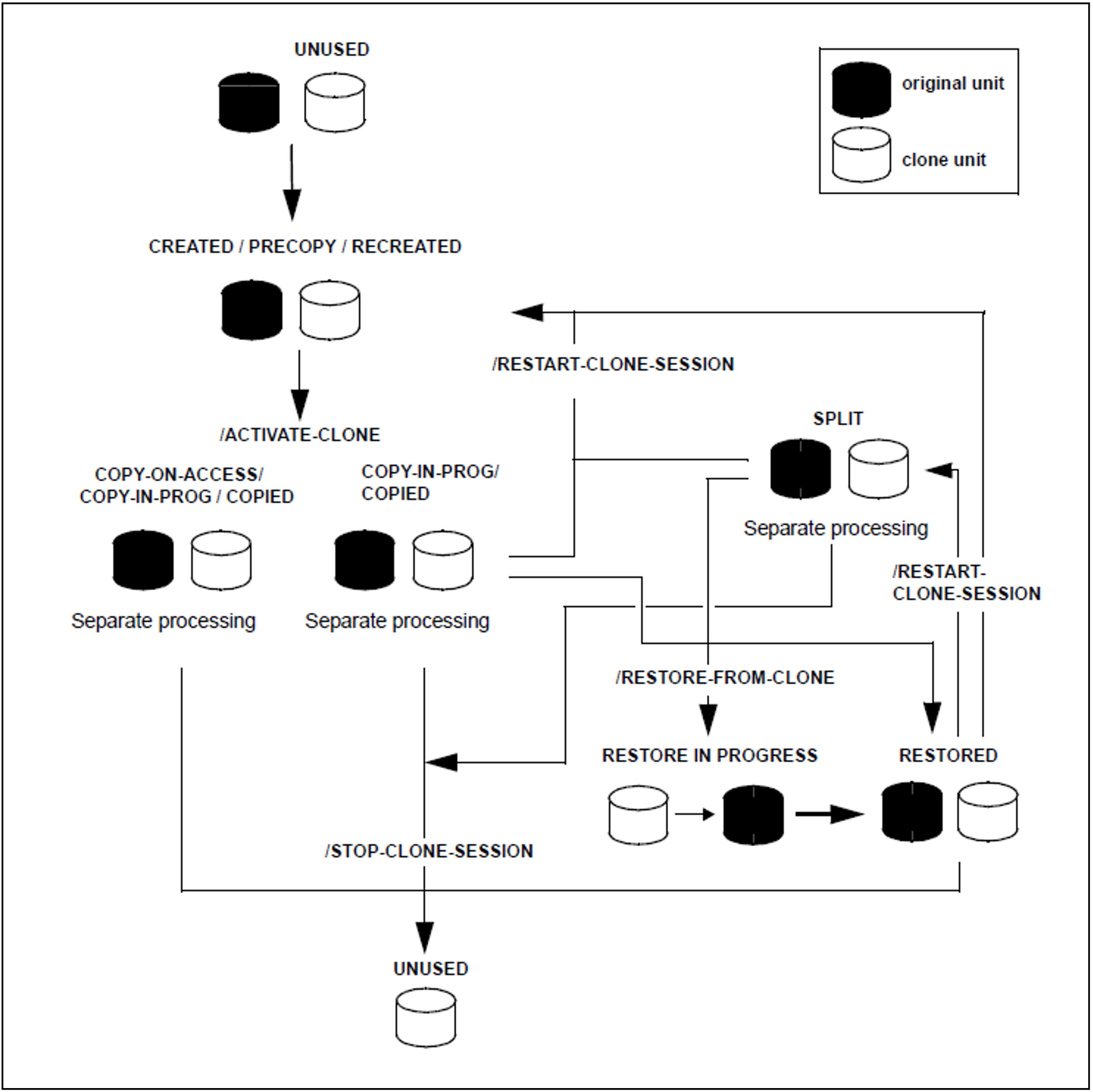This section describes the function TimeFinder/Clone of the TimeFinder product family. All products of this family enable (additional) copies of the application data to be created within a storage system.
For VMAX3, TimeFinder/Clone is implemented by SHC-OSD in the previous functional scope with the previous interfaces. SYMAPI emulates TimeFinder/Clone via TimeFinder SnapVX. The statements in this chapter therefore also apply for VMAX3.
Overview
TimeFinder/Clone creates a copy of the original unit at a particular time (“Point-in-Time copy”), either in the form of a complete copy or a “snapshot”. In both cases the copy, which is called a clone unit, is available immediately after it has been activated.
Together the original unit and clone unit form the clone pair. TimeFinder/Clone manages this in a clone session.
For simplicity’s sake, the term unit is generally used in this manual instead of original unit. A clone pair therefore consists of a unit and a clone unit.
TimeFinder/Clone creates a clone unit in accordance with the “Copy-On-Access strategy”: Data (more precisely: tracks) is copied to the clone unit when the data on the unit is accessed in write mode or that on the clone unit in read mode. When TimeFinder/Clone copies the unit in full, this is done in the background. TimeFinder/Clone requires no specially preconfigured devices. Any units of the Symmetrix/VMAX3 can be used as clone units.
After they are activated, the unit and clone unit are split, which enables both to be processed separately, for example by different applications.
After separate processing has been completed, either the original data or the copy can be updated to restore their identical status. If the copy is discarded, the clone session is terminated and the clone unit is released again.
TimeFinder/Clone can also be used in conjunction with SRDF for SRDF source units or SRDF target units.
SHC-OSD offers consistent generation of a pubset’s clone units during ongoing operation. Stopping all inputs/outputs on all the units concerned while splitting is in progress ensures data consistency. Among other things, this can be used to create a consistent standby pubset from the home pubset.
Figure 12: TimeFinder/Clone
Application
The clone units which are provided by TimeFinder/Clone and are immediately available supply copies of the productive application data. Data backups, batch evaluations and program tests can consequently be executed on the copies. The original data is available in parallel to the main application, and as a result the latter can remain productive longer.
The copies generated using TimeFinder/Clone can be used for data backup (e.g. with HSMS or FDDRL). Replicas of databases can be generated with clone units.
Migration
The TimeFinder/Clone function is ideally suited to migrating data. To do this, a clone session with a complete data copy is set up between the unit with the data to be migrated and the target unit (= clone unit), if required between multiple original and multiple target units.
After the clone unit has been activated and the copy procedure has been completed, the data is available on the new clone unit. The clone session is now terminated and the clone unit can be used directly. Further replication is possible using SRDF and/or TimeFinder.
Clone units in Symmetrix/VMAX3
TimeFinder/Clone does not require specially configured device types in the storage system. Freely available devices can be used as clone units. Meta volumes can also be used as clone units provided they match the original units in terms of stripe size and stripe count.
Clone units can have a greater capacity than the original units. This is particularly interesting for migration scenarios. The software product SPACEOPT (see the "SPACEOPT" manual [14]) enables the additional capacity to be made available for BS2000.
The units used as clone units must be generated like any other disk of the BS2000 server.
Up to 16 clone units can be configured for a unit. This value is determined by the current storage systems, which permit a maximum of 16 copy sessions per original device. This value consists of the sum of clone and snap sessions which are active at a given time. The first snap session counts twice. All snap units for a unit are regarded as a single snap session.

